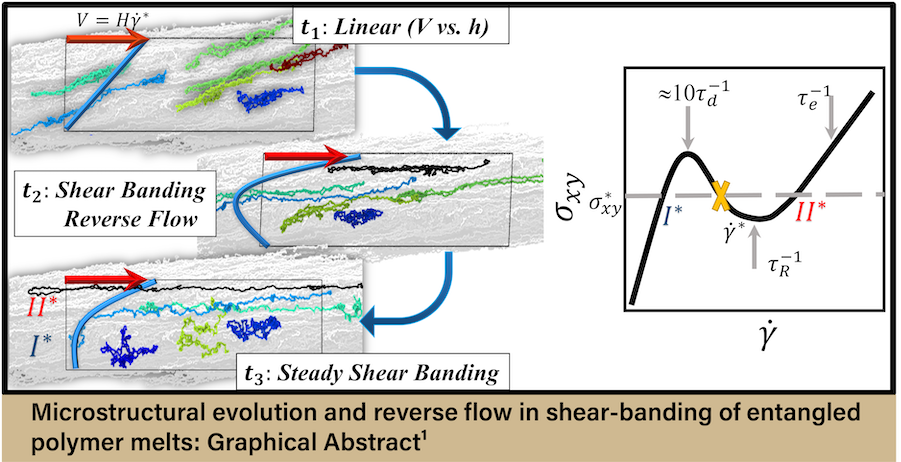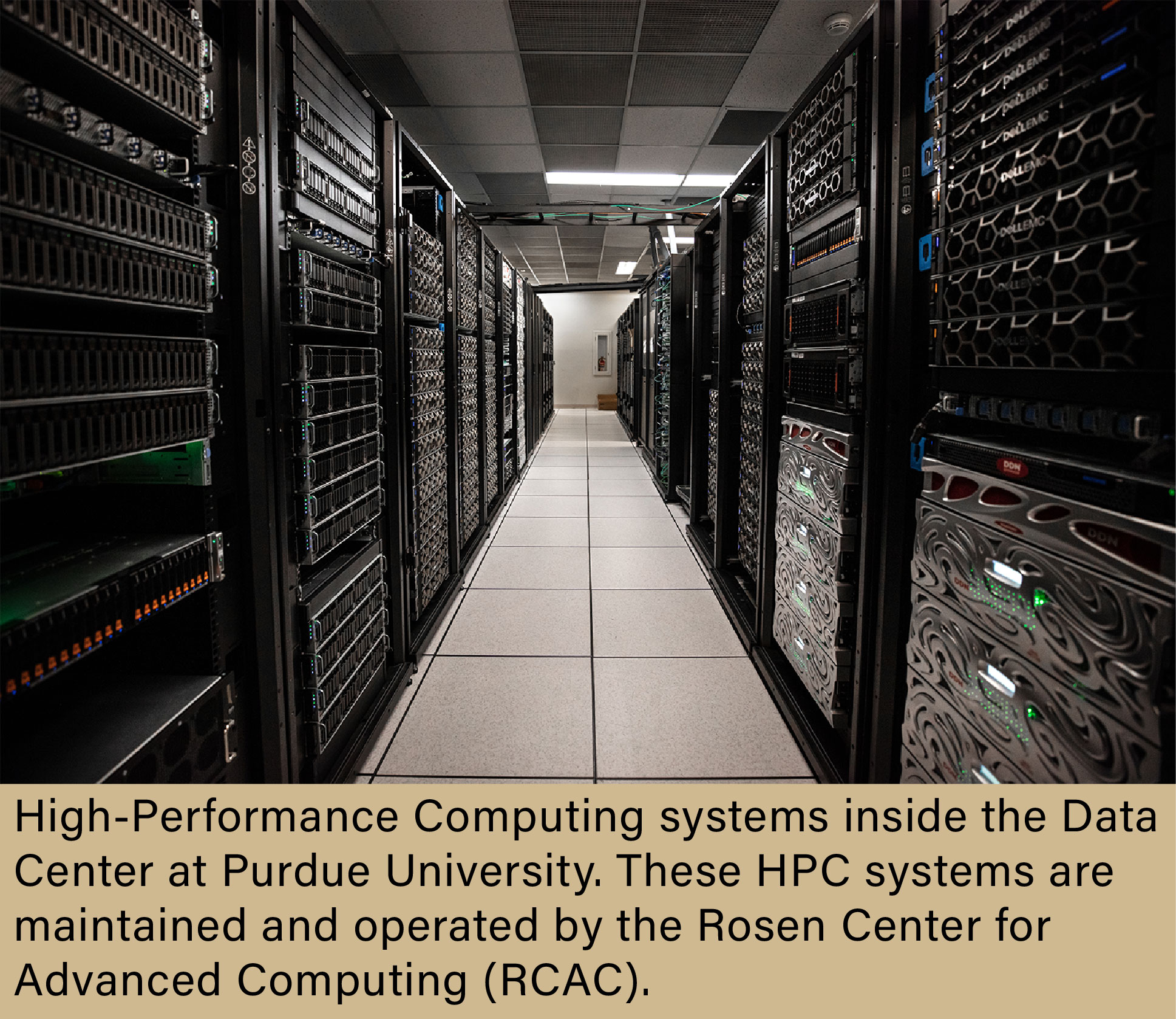Researchers use Anvil supercomputer to study instabilities in polymers
Scientists from the Material Research and Innovation Laboratory (MRAIL) at the University of Tennessee-Knoxville used the Anvil supercomputer to obtain a deeper understanding of the Flow-induced structural instabilities of polymers and polymer dynamics.
Dr. Mahdi Boudaghi, Dr. Brian Edwards, and  Dr. Bamin Khomami used Anvil to perform virtual experimentations through computational simulations of polymers under the startup of shear flow in order to learn what happens on a molecular scale under different nonequilibrium conditions. The researchers were specifically interested in a phenomenon known as shear banding, a commonly observed but incompletely understood occurrence that can lead to polymer processing instabilities.
Dr. Bamin Khomami used Anvil to perform virtual experimentations through computational simulations of polymers under the startup of shear flow in order to learn what happens on a molecular scale under different nonequilibrium conditions. The researchers were specifically interested in a phenomenon known as shear banding, a commonly observed but incompletely understood occurrence that can lead to polymer processing instabilities.
“In short,” says Dr. Boudaghi, “The objective of our research was to elucidate the underlying physics of nonlinear phenomena that occur during the flow of non-Newtonian viscoelastic liquids. We employed multiscale molecular dynamic simulation of polymer melts and solutions to uncover and explain a comprehensive picture of the effect of shear and extensional flow on the microstructure of these complex materials. In particular, we illustrated the microstructure-to-property relationships that result from non-linear phenomena like shear banding and conformational segregation. The cutting-edge computational facilities such as Anvil enabled us to push the boundaries of computational modeling and conduct large-scale simulations of polymeric materials representative of the real world.”
Polymers are materials and substances with large molecules made up of repeating units of different chemical compounds. Polymers can be natural, such as many of the proteins within the body, or they can be synthetic, like nylon and polyester. These polymeric materials are incredibly useful to manufacturing, industry, and commerce. Dr. Boudaghi and the MRAIL team focused their research on obtaining a deeper understanding of the dynamics of linear polyethylene—one of the most commonly produced plastics—to explain and predict the instances in which shear banding might arise during their processing. To quote one of the team’s publications1:
“The impact of understanding the mechanism of shear banding in polymer solutions and melts could be profound and help to explain any number of previously poorly understood phenomena observed in viscoelastic fluid mechanics.”
Learning about the fundamental mechanisms that cause shear banding in polymers could lead to developing higher-quality products, advancing polymer production worldwide. But to obtain a deeper understanding of polymers, the team needed to run very complex and sophisticated simulations. Specifically, they needed to use a dissipative particle dynamics (DPD) force-field model to perform high-fidelity, large-scale simulations of entangled polymer solutions. These simulations showed the nonlinear physics behind the evolution of shear banding phenomenon within the polymer liquids on a molecular level during the startup of shear flow. And these simulations would be impossible without high-performance computing (HPC).
“Still, there are many unknown mechanisms in polymer physics when it comes to studying polymer dynamics,” says Dr. Boudaghi. “Our understanding of polymeric materials is often limited when relying solely on continuum-level models and experimentation. This is due to the fact that material properties and behaviors are deeply rooted in their microstructure, as well as the inter/intra-molecular interactions. Thus, detailed techniques, such as molecular-level modeling, are essential to gain a comprehensive understanding of nonlinear viscoelasticity. Molecular dynamics and multiscale simulations are valuable methods which provide us the capability to ‘see’ through a material at a molecular scale, allowing us to understand the fundamentals and the effects of phenomena happening on a molecular level on the continuum-level properties. However, due to high degrees of freedom, these simulations are computationally intensive and demand significant simulation time, necessitating the use of high-performance computing facilities. The accessibility to advanced computing resources empowers us as scientists and enables direct comparisons of simulation results with experimental findings. Therefore, high-performance computing and parallel computing are invaluable assets that broaden our scientific horizons.”
In order to use these much-needed  HPC resources, Dr. Boudaghi and his PI’s applied for allocations through the NSF-funded program known as Advanced Cyberinfrastructure Coordination Ecosystem: Services & Support (ACCESS), which manages access to national cyberinfrastructure (CI) resources. They were able to obtain allocations to the Anvil supercomputing system during its early-user program, utilizing mostly CPUs (but some GPUs) to complete their research. Anvil performed very well for the team, giving them the speed and parallel computing power they needed to easily run their simulations.
HPC resources, Dr. Boudaghi and his PI’s applied for allocations through the NSF-funded program known as Advanced Cyberinfrastructure Coordination Ecosystem: Services & Support (ACCESS), which manages access to national cyberinfrastructure (CI) resources. They were able to obtain allocations to the Anvil supercomputing system during its early-user program, utilizing mostly CPUs (but some GPUs) to complete their research. Anvil performed very well for the team, giving them the speed and parallel computing power they needed to easily run their simulations.
“Starting with the early-user program,” says Dr. Boudaghi, “Anvil has been a valuable resource for us, providing a great experience. While we’ve also been using other machines available through ACCESS, it’s clear that Anvil stands out as highly advanced and, in some instances, exhibits superior efficiency compared to the other machines.”
The team was also pleased with the level of support provided by the Anvil team. “The Anvil team has consistently demonstrated their responsiveness and helpfulness whenever we had questions. Whether it was regarding the executables, scheduler, resources, or the need for specific code for an application, they were instrumental in addressing and resolving the issues we encountered.”
Overall, the research performed by Dr. Boudaghi and his co-authors was very successful. The simulations elucidated many outstanding questions surrounding the shear banding in polymers, and the results agree with suggestive mechanisms in physical experimentation. To learn more about the details of their results, please refer to the series of featured publications by the team:
1) Microstructural evolution and reverse flow in shear-banding of entangled polymer melts1
2) Molecular Processes Leading to Shear Banding in Entangled Polymeric Solutions2
Anvil is Purdue University’s most powerful supercomputer, providing researchers from diverse backgrounds with advanced computing capabilities. Built through a $10 million system acquisition grant from the National Science Foundation (NSF), Anvil supports scientific discovery by providing resources through the NSF’s Advanced Cyberinfrastructure Coordination Ecosystem: Services & Support (ACCESS), a program that serves tens of thousands of researchers across the United States.
For more information regarding HPC and how it can help you, please visit our “Why HPC?” page.
Researchers may request access to Anvil via the ACCESS allocations process. More information about Anvil is available on Purdue’s Anvil website. Anyone with questions should contact anvil@purdue.edu. Anvil is funded under NSF award No. 2005632.
References:
- Boudaghi, Mahdi, Brian J. Edwards, and Bamin Khomami. 2023. “Molecular Processes Leading to Shear Banding in Entangled Polymeric Solutions” Polymers 15, no. 15: 3264. https://doi.org/10.3390/polym15153264
- Boudaghi, Mahdi, Brian J. Edwards, and Bamin Khomami. “Microstructural Evolution and Reverse Flow in Shear-Banding of Entangled Polymer Melts.” Soft Matter 19, no. 3 (January 18, 2023): 410–29. https://doi.org/10.1039/D2SM01337A.
- Boudaghi, Mahdi, Brian J. Edwards, and Bamin Khomami. “Effects of chain length and polydispersity on shear banding in simple shear flow of polymeric melts.” Soft Matter 16 (28), 6468-6483 (2020). https://doi.org/10.1039/D0SM00669F
Written by: Jonathan Poole, poole43@purdue.edu
